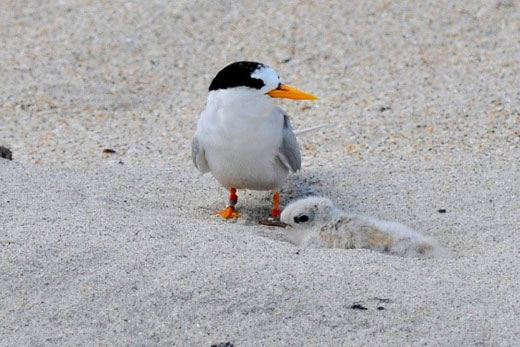Forest and Bird's seabird of the year competition came down to a last-minute struggle between two species of critically endangered birds this year, the fairy tern and the Fiji petrel.
A fairy tern. Photo: David Hallett.
The fairy tern won with a late surge to 1882 votes compared with the Fiji petrel's 1803 with the lead changing several times. Third placed little blue penguin received 563 votes.
Conservationist, author and co-campaign manager for the fairy tern, Wade Doak, says the fairy tern's win is great news for the species, and for the people who work so hard to protect it.
'Sadly, the dwindling numbers of fairy tern are disproportionate to their popularity, with only between eight-10 breeding pairs of the birds left,” says Wade.
'The upside is there are plenty of people prepared to go to great lengths to save the fairy tern.
'Regardless of the conditions at Mangawhai Heads, you'll almost always find a solitary figure – sitting on an upturned bucket – guarding a fairy tern colony.
'The courage and devotion of the public to saving these birds is incredible. Which is fortunate, because it's entirely up to us as to whether the birds will survive,” says Wade.
Campaign manager for the Fiji petrel on behalf of NatureFiji-MareqetiViti Steve Cranwell says the support of Fijians, and Fijians at heart, for the Fiji petrel campaign exceeded all expectations.
'To all New Zealanders who included the Fiji petrel as part of the Pacifica family, vinaka vakalevu [thank you],” says Steve.
Forest and Bird seabirds advocate Karen Baird says the light-hearted poll serves the purpose of making people aware New Zealand has more native seabirds than any other country in the world.
'New Zealand is a seabird superpower. More than one-third of the world's seabird species spend at least part of their lives here. Thirty-six of those only breed here.
'But nearly half the 86 seabirds in total that breed in New Zealand are threatened with extinction,” says Karen.
'It was interesting because the bird of the year competition dealt with seabirds for the first time.”
Karen says most seabirds don't recognise boundaries.
'Many of our species migrate and go into other countries jurisdictions, and the reverse is true,” says Karen. 'The Fijian petrel is an extremely rare bird. One of the reasons for highlighting it.
'The Fiji petrel is so rare we don't know where it goes, but because it's highly endangered and we're working very hard to try and protect it, it was a good one to highlight and it was great to see Fijians getting behind their bird. It was really neat to see that.”
There are thought to be less than 50 Fijian petrels and about 40 fairy terns.
Birds seen in the Bay of Plenty also featured in the competition. The Black Petrel, which nest of Great Barrier and Little Barrier. had a campaign slogan ‘vote black'.
Shearwaters that breed on the Poor Knight Islands come to the Bay of Plenty to feed, says Karen. The Bay of Plenty also has diving petrels and shearwaters.
The bird most commonly-killed by the cargo ship the Rena's oil spill was the little diving petrel, says Karen.
'They are an amazing bird,” says Karen. They spend almost as much time under water as penguins, but they can also fly.
'We are really excited to have had Sea Bird of the Year this year. It's just been a change to highlight how many seabirds we have. Most people wouldn't know we have more seabirds than we have land birds.
'Everyone knows about tui and bellbirds and kakapo and all those sorts of things, but it's very hard to get to know sea birds because they are mostly away from the shore; and even when you are out in a boat, they are quite hard to tell apart.
'They are quite hard to get to know. Everyone knows penguins, which is probably why the blue penguin came third.”



1 comment
Nice
Posted on 29-12-2014 10:25 | By Capt_Kaveman
Choice
Leave a Comment
You must be logged in to make a comment.